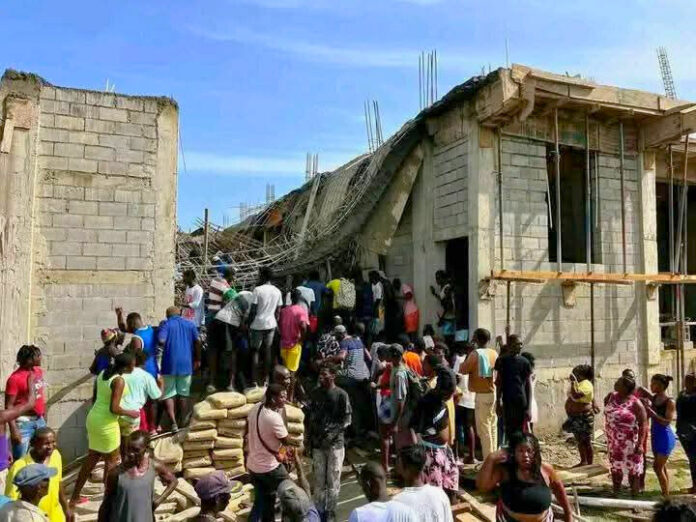Overview:
A house being built in Ouanaminthe, northeast Haiti, collapsed on July 1, leaving two workers dead and nearly a dozen others injured. Local officials and residents blame unauthorized construction, ignoring safety protocols, the use of poor materials and a lack of oversight for the tragedy.
OUANAMINTHE, Haiti — A house under construction collapsed July 1 in Ouanaminthe, killing two workers and critically injuring nearly a dozen others. The deadly failure has reignited scrutiny over poor construction practices and the government’s failure to enforce building safety regulations.
“These people had never applied for a permit from the town hall, which is why the town hall engineer did not supervise the construction site,” said Luma Démétrius, interim mayor of Ouanaminthe.
The incident occurred on National Road 6 in upper Maribaroux, less than a mile from the city center, where a concrete building under construction abruptly caved in. Workers and residents rushed to dig through the rubble, recovering two bodies at the scene and transporting the injured to local hospitals using motorcycles and tricycles.
Officials and residents quickly attributed the construction site tragedy to poor materials, inadequate planning and a total lack of oversight—factors that have plagued construction across Haiti for years.
Framing failure, shoddy materials and accountability missing at every level
Eyewitnesses and construction experts point to basic engineering flaws. Thélusmond Jean-Baptiste, Administrative Council of the Maribaroux communal section (CASEC), described a “large part of the ceiling” falling and causing “considerable damage.”
Construction specialist Henry Pierre, known as Bòs Chapant, a Haitian Creole term meaning “Master Carpenter,” said the roof’s collapse was due to poor framing and the use of substandard wood.
“The problem stemmed from poor placement of the metal structure and the use of low-quality materials,” Pierre said.
Ironworker Elius Fleurant added that the site lacked coordination between trades and failed to conduct a structural study before pouring concrete—resulting in a deadly overload.
Responsibility for the unsafe project remains murky. Local officials said they had no authority to intervene, while others blamed the state outright.
“These people had never applied for a permit from the town hall, which is why the town hall engineer did not supervise the construction site.”
Luma Démétrius, Interim Mayor of Ouanaminthe
“It is because of the negligence of the municipal authorities that the city recorded this tragedy,” said Miribel Charles, deputy delegate of Ouanaminthe.
Civil engineer Lesly Théogène, director of the Ministry of Commerce and Industry, echoed the sentiment: “This house was built without the supervision of the competent authorities.”
Meanwhile, Joseph Fleury of the Northeast Civil Protection Service said authorities couldn’t immediately identify the victims, citing documentation issues and uncertainty over their origins—highlighting the lack of traceability of laborers on-site.
The head construction worker, Jean Sévère, was among the dead. He had reportedly taken over after a dispute between the project’s original engineer and its manager, who later left the site.

A warning long unheeded: Unsafe practices amid migration and desperation
Ouanaminthe has become a hotspot for construction, especially since a wave of Dominican deportations and internal migration due to gang violence brought a surge of unskilled labor to the area. Many of the workers are undocumented, lack formal training and accept risky jobs out of economic desperation.
“The workers who died in this collapse made a living from this activity,” said Justice of the Peace Beaumanois Marcellus.
Departmental Delegate Dionel German said the site was built in a non-zoned swamp area and that “people were not obtaining permits.” He called for stricter vigilance—but offered no clear plan for systemic reform.
While construction remains vital to economic development, this tragedy underscores how, without regulation, it becomes a death trap for Haiti’s working class. Multiple sources confirmed that no proper survey had been conducted and no official oversight was in place—common issues across the country.
“It is time for the Haitian government, in collaboration with local communities and construction professionals, to take responsibility to prevent future disasters,” said Théogène.
The collapse in Ouanaminthe is the latest example of Haiti’s systemic construction failures—one official warns—that will keep recurring without urgent reform.
